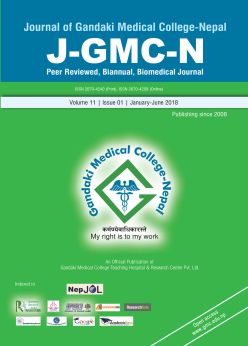Etiological Profile and Management of Epistaxis in Tertiary Care Hospital
DOI:
https://doi.org/10.3126/jgmcn.v12i1.22603Keywords:
Endoscopy, Epistaxis, Nasal packingAbstract
Introduction: Epistaxis is a common otolaryngological emergency condition. It occurs due to local and systemic cause. Local cause lies within the nose bleeding either anterior or posterior. Commonest site of bleeding anterior epistaxis is kiesselbach’s plexus. In posterior epistaxis, it is difficult to locate bleeding site. Epistaxis is controlled by simply pinching of nose, decongested nasal drop and abgel packing. Some cases become more challenging required nasal packing and arterial ligation.
Objectives: To study the epidemiological pattern and management of epistaxis.
Methods: This was a retrospective study on pattern of epistaxis managed at Gandaki Medical College Teaching Hospital over a period from April 2015 to April 2016. Information regarding demographic profile, presentation and management of epistaxis was obtained from the Hospital records, ENT Outpatient clinic, Emergency Department, ENT ward and operation theatre.
Results: A total of 78 cases were managed during study period. There was a significant male preponderance with male to female ratio 1.78:1. Patients’ age varied from eight to 80 years with mean age 40.7 years. The peak age of incidence was 21 - 30 years group. Idiopathic nasal bleeding 27 (34.6%) was commonest followed by nasal trauma 23 (29.5%) cases and hypertension 16 (20.5%) cases. Seventeen (21.8%) cases managed in day care basis with decongested nasal drop, chemical cautery and abgel packing. Remaining cases required nasal packing and bipolar cautery and other specific form of treatment. Five (6.4%) cases required sphenopalatine artery ligation with no recurrence of bleeding.
Conclusions: Epistaxis is common ENT emergency. Most common causes are idiopathic followed by nasal trauma and hypertension. Prompt management is instituted according to cases. Most of the cases are managed by non-surgical method.
Downloads
Downloads
Published
How to Cite
Issue
Section
License
This license allows reusers to distribute, remix, adapt, and build upon the material in any medium or format for noncommercial purposes only, and only so long as attribution is given to the creator.

